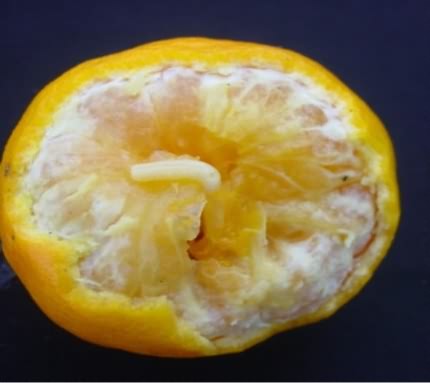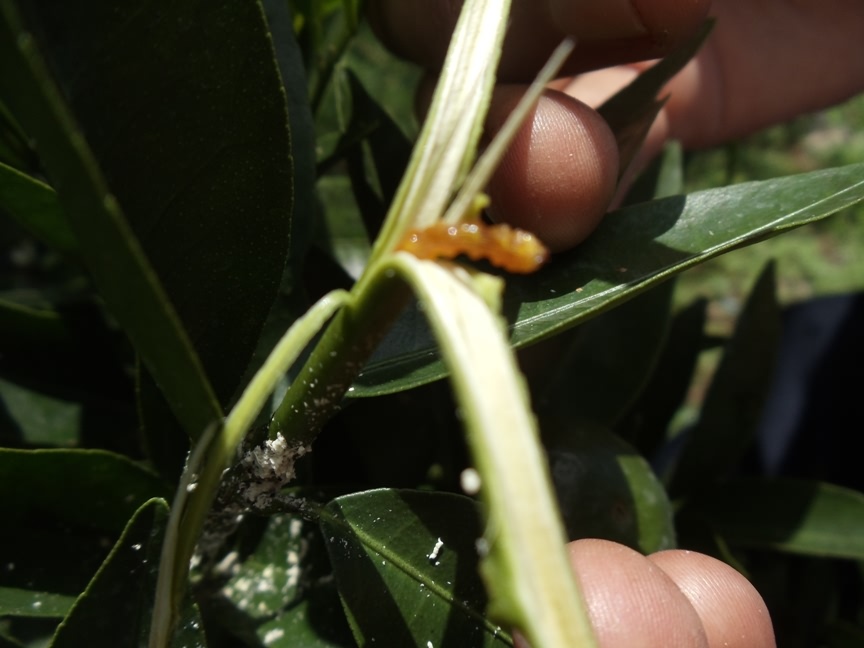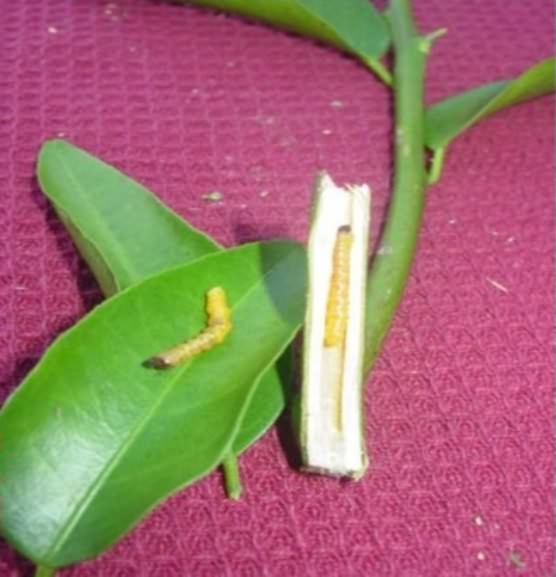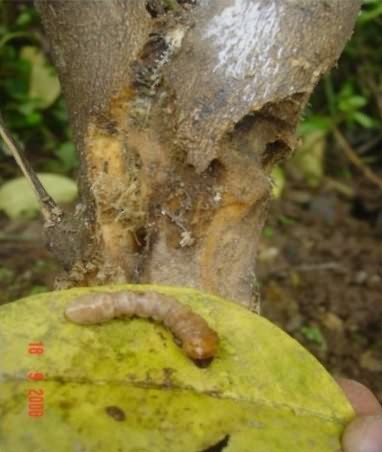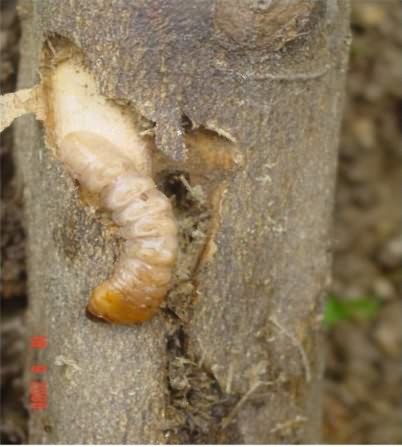Major insect pests problematic to mandarin orange in North Eastern Hill regions of Darjeeling and Sikkim are leaf miner, citrus psylla, citrus fruit sucking moth, citrus stem borer etc. These major insects and their management are as following-
 1. Citrus leaf miner (Phyllocnistis citrella):
1. Citrus leaf miner (Phyllocnistis citrella):
It is a common pest of citrus crops in India. The adult of this pest is a minute silvery white or greyish moth. Usually leaf miner is more active during their growth period i.e., in spring and rainy seasons.
Tender leaves are attacked and leaf miner larvae feed on the epidermis, producing silver coloured serpentine mines, generally on the lower surface. Often the tiny caterpillars/grubs are found in them. Larvae also attack the tender branches where they mine under the epidermis.
Both young and old trees are affected but the damage to young plants is more serious. A heavy attack may lead severe defoliation.
The infested trees are devitalized and look sickly. Leaves which are mined also serve as loci of infection for citrus canker disease.
Management:
- Chipping and destruction of mined leaves in the primary stage reduces insect infestation.
- Timely sprays of Dimethoate @ 2ml/L of water or Profenofos @ 2-3ml/L of water or Thiamethoxam @ 0.2 g/L of water provide satisfactory control.
- Regular monitoring plays vital role in the management of the insect.
2. Citrus psylla (Diaphorina citri):
The damage is mainly caused by the nymphs of citrus psylla, which suck the sap from the leaves, young shoots, buds, flowers and tender branches; flowers shed in large numbers. The infested leaves curl and fall off prematurely. In severe cases, they may weaken the trees.
The fruits remain small and of poor quality. The twigs and sometimes the entire tree may decline. The nymphs secrete honeydew like substance on which sooty mould fungus develops. The sooty mould fungus does not allow the plants to grow vigourously by affecting its photosynthesis, adversely.
Citrus psylla is also reported to be a vector of citrus greening bacterium and indirectly damages the plants more.
Management:
- Diseased plant parts should be pruned and destroyed by burning them.
- Spraying the trees with resin compound, crude oil emulsion with sulphur gives satisfactory control.
- Spraying of Fenvalerate @ 1 ml/L of water or Metasystox @ 2 ml/L of water or Phosalone @ 1.5–2.0 ml/L of water or Profenofos @ 3 ml/L of water or Thiamethoxam @ 0.2 g/L of water also effectively reduce population of the insect.
- Hoverflies, lady bird beetles and lacewing insects are reported as predators of this pest. The population of these natural enemies should be promoted for effective, eco-friendly management of citrus psylla insect.
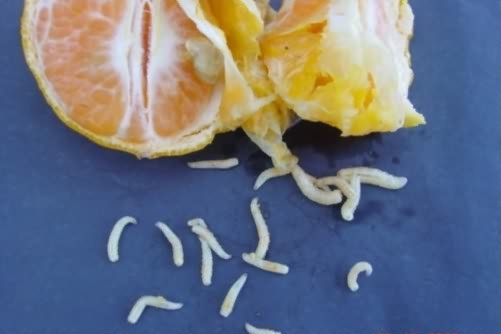 3. Citrus Fruit flies (Bactrocera dorsalis):
3. Citrus Fruit flies (Bactrocera dorsalis):
Sometimes, these are very serious pests in Darjeeling and Sikkim hills, especially during the monsoon season.
The fruit fly looks almost similar to the housefly, and can be distinguished from the common housefly by its triangular shaped abdomen and spotted wings. The fruit flies lay eggs under the ripening fruit rind by means of its piercing ovipositor.
The eggs hatch out within few days and the maggots start feeding inside fruits. These maggots spoil the taste and market value of these fruits. The damage occurs more, if the fruits are retained late on the trees after maturity.
The affected fruits can be easily distinguished by the presence of a rotten, round patch at the place where it was pierced by the flies.
Affected fruits fall on the ground. The maggot pupates in the soil and emerges as flies after 7-10 days.
- Fruit flies are very difficult to be controlled. Infested fruits should be collected and burnt so that the maggots are killed. The maggots must not be allowed to emerge out from the fruits and pupate in the soil.
- Raking or ploughing the soil to destroy pupae is beneficial and application of Carbaryl dust to soil underneath the tree canopy kills the pupating maggots and pupae, and help in reducing infestation level.
- Bagging of the still hard and green fruits with craft paper bags also avoids damage.
- Installation of methyl eugenol trap is found quite effective in managing the population.
- Citrus fruit flies can be effectively controlled by poison baiting with 20 ml Malathion or 50 ml Diazinon mixed with 200 g gur (jaggery) in 2 liters of water. This mixture is filled in plastic tub and 60 watt bulb is fixed over it to attract moth during night time. Moths will be attracted towards light trap. After falling in this mixture moths get killed. The fallen fruits should be buried in a pit and cover with soil every day.
4. Lemon butterfly (Papilio demoleus):
Caterpillars of the butterfly are commonly seen feeding voraciously on the leaves of citrus plants. They are more damaging to the young plants, as compared to older trees.
Considerable damage is caused to citrus plants by this insect in the nursery and young orchards. In severe cases, they completely defoliate the plants.
The caterpillars are cylindrical, dark brown with irregular whitish markings on dorsal side of the abdomen; and may assume size up to two inches in length. Larvae resemble bird's drooping to escape from predators.
The larvae eat the tender leaves and develop into thick green coloured one. Larvae are voracious eaters of the leaves and can devour entire foliage.
This can be a serious pest in nursery also. These insects are more damaging in the months of March–May and again in August–October.
Management:
- This pest can be picked up and destroyed mechanically in larval (caterpillar) and pupal stages when their population is low or when the attack has just started.
- Spraying the crop with Chlorpyrifos @ 3 ml/ L water or Deltamethrin/ Fenvalerate @ 1ml/ L or Carbaryl @ 2.5 g/L of water is also effective against this pest.
- Spraying the crop with NSKE @ 3-5 ml/L of water also reduces the insect infestation effectively.
5. Fruit sucking moths (Otheris fullonica, Achaea janata L.):
These moths are grey in colour and have orange colour wings. The adult moths fly at night and cause damage by sucking the juice from the ripe fruit by drilling holes in it. The green fruits are also not spared from attack.
As a result, the area around the puncture caused by the proboscis becomes soft and fungal and bacterial infection take place there. The affected fruits gradually begin to rot, become worthless and fall down immediately or within few days. Fruit sucking moths attack during the rainy season.
Management:
- The population of this insect can be minimized by avoiding the rainy season crop.
- This pest has alternate wild hosts, hence the elimination of larval host plants help in protecting the orchards.
- Capturing the moths by hand nets, baited traps (with or without poison) smoking and prompt burning of fallen and decaying fruits and early harvesting or covering individual fruits when half ripe with paper bags help in managing this insect.
- Fruit sucking moth can be effectively controlled by poison baiting with 20 ml Malathion or 50 ml Diazinon mixed with 200 g gur (jaggery) in 2 liters of water. This mixture is filled in plastic tub and 60 watt bulb is fixed over it to attract moth during night time. Moths will be attracted towards light trap. After falling in this mixture moths get killed.
- Since, the moths are attracted to light; placing a strong light over water mixed with kerosene reduced their population.
- Spraying the fruits with NSKE @ 3-5 ml/L of water or Rynaxypyr 0.33 ml/L of water or Flubendiamide 0.25 ml/ L of water also gives satisfactory control.
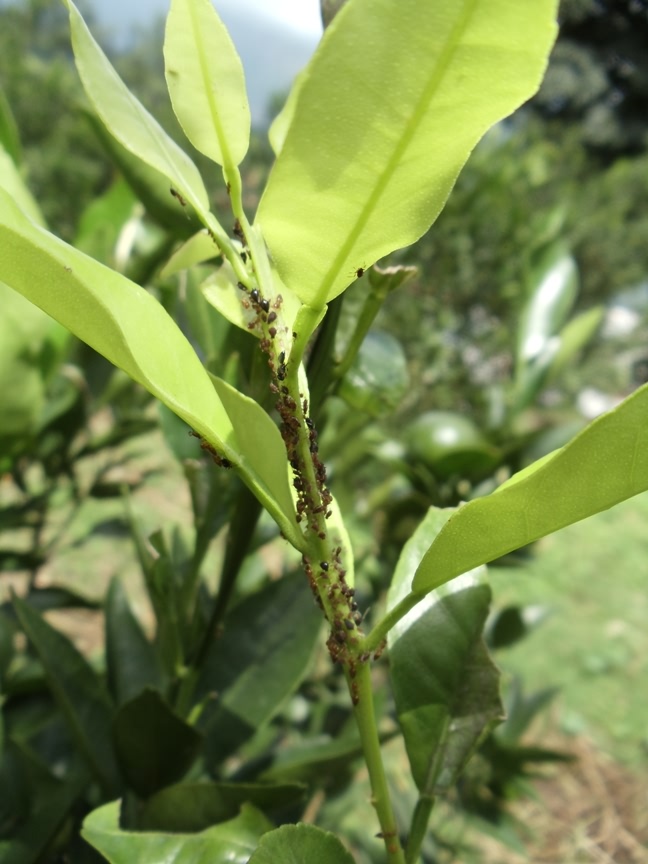 6. Aphids of Orange (Toxoptera citricida):
6. Aphids of Orange (Toxoptera citricida):
Aphids are tiny green or black sucking insects found adhering in clusters to the underside of young citrus leaves and new shoots. In India, brown citrus aphids and black citrus aphid are more prevalent and cause major damage.
Aphids are more active during December-March. The affected leaves curl, deform and growth of the young shoots is checked. Sometimes, blossoms and newly set fruits are also attacked.
They secrete a honey dew like substance on which sooty-mould grows, which impairs the normal functioning of leaves. Citrus aphids are more important with respect to the spread of Citrus Tristeza Virus in citrus orchards. Brown citrus aphid is the main vector of this dreadful virus.
Management:
- Generally, aphids are kept in check by predators such as lady bird beetle or other natural enemies, which feed on them. If sufficient numbers of such beetles are absent, aphid attack may become severe. Under such conditions, control measures become essential, and it must be taken up before leaves begin curling.
- For spraying Malathion 2.5 ml/L of water or Imidacloprid @ 0.25–0.50ml/L of water or Thiamethoxam @ 0.25 g/L of water or Acetamiprid @ 0.3 g/L of water may be used for effective management. Besides these NSKE @ 3-5 ml/L of water may also be used.
7. Shoot borer/Trunk borer:
It attacks more vigourously in September-October. Fresh hatched larvae bore into the young twigs and feed on the soft tissues. This insect feed upon bark of citrus tree during day hours and hide itself in holes bored into the shoots/ twigs in the night. Affected twigs break and dry. Severely affected plants lose its vigour and look sickly.
The trunk borer insect is very serious pest of citrus plants. The grub of the trunk borer insect bores the tree trunk near ground level horizontally up to the pith and then tunnels vertically and again horizontally for exit. The attacked tree gradually dries up with leaves turning yellow and drop off prematurely.
Management:
- The affected branches/shoots should be pruned 4-5 cm below the dried portions and destroyed.
- Do not cause any physical injury to the trunk or main branches.
- After pruning spraying the crop with Monocrotophos 36 WSC @ 1 ml/L of water or Quinalphos 25 EC @ 1.5 ml/L of water or Carbaryl 50 WP @ 2 g/ L of water reduces the insect infestation considerably.
- Inject kerosene oil/ petrol and plug the hole with wet clay.
- Swabbing of tunnel and plugging the fresh holes either with Dichlorvos (0.5%) or Monocrotophos (5 ml/20 ml of water) kills the trunk borer grubs effectively.
8. Citrus decline complex:
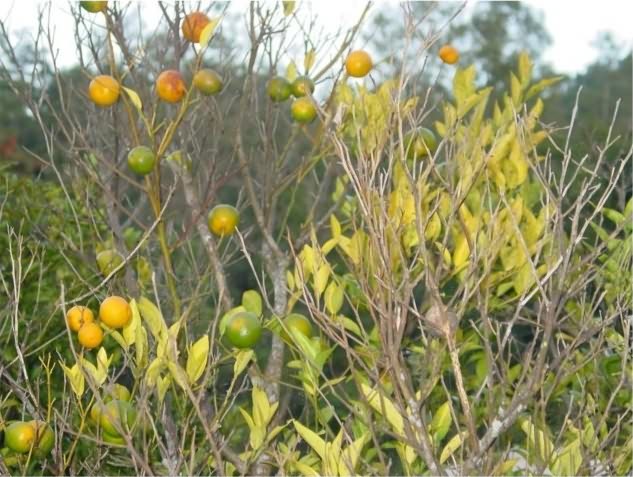 Citrus decline, also often referred as citrus "die back" is not a specific disease but is a symptomatic expression of many disorders in the plant. The term die back actually describes the continuous dying of twigs downward.
Citrus decline, also often referred as citrus "die back" is not a specific disease but is a symptomatic expression of many disorders in the plant. The term die back actually describes the continuous dying of twigs downward.
The earliest symptom of decline is the complete suppression of normal seasonal flushes. Affected trees blossom heavily, produce a large crop and collapse suddenly.
Symptoms of decline may vary with the cause of the malady. All the citrus species and varieties are susceptible, but the sweet and mandarin oranges are worst affected by this problem. Budded, as well as, seedling trees suffer from this malady. In early stages, symptoms are restricted to a few limbs, but eventually the whole tree is involved.
Trees show sparse mottling leaves, stunted growth, and sickly appearance. Midrib and lateral veins of old, mature leaves turn yellow with interveinal areas along the veins showing diffuse yellowing.
Leaves may turn yellow and are shed with the onset of summer or autumn and the die-back of twigs starts. The die-back symptoms may reach down to the main trunk.
The entire tree bears short twigs carrying narrow small leaves on their lower portion. Subsequent secondary growth consists of short, upright small, weak shoots showing a variety of discolouration of leaves. Often these leaves have green veins of green blotches. Occasionally, small, circular, green spots appear on yellow tissue on leaves.
The die-back of weak shoots continues. There is excessive flowering, but the fruits are not carried to maturity. The fruits show distinct sun-blotching. The feeder root system becomes depleted; roots turn black and sometimes are covered with rotting bark. Either only a few trees or entire orchard may be affected. Some-times citrus tree may suddenly wilt and die within a day or two.
Factors responsible for citrus decline:
A number of factors are responsible for the decline of citrus trees. Some important factors are discussed below –
Nutritional factors: Plant nutrition is among the most important factors responsible for citrus decline. Citrus decline of oranges in hilly regions is due to the deficiencies of several mineral elements including zinc, manganese and boron.
Rootstock factors: Rough lemon is widely used as rootstock in India and some other countries. In many instances, failure of citrus trees may be attributed to incompatibility between stock and scion. Susceptibility of rootstocks to root rots, salinity, water logging, cold, virus etc. also leads to citrus decline.
Orchard management factors: Mismanagement and negligence in orchard practices can lead to decline of citrus trees. Excessive intercropping, faulty methods used, excess or no manuring, improper irrigation, are some of the common causes leading to citrus decline. Bad drainage causes poor aeration due to poor aeration plant root developments arrested, leading to less absorption of the nutrients and ultimately to the decline of the top.
Insect pests: Several insects attack citrus and cause damage by direct feeding and by acting as vectors for viruses and other pathogens. Citrus leaf minor is a very serious pest of citrus foliage. White flies reduce plant vigour by sucking plant sap.
The nymphs and adults of citrus psylla suck sap from leaves and tender shoots causing curling and defoliation and death of shoots. Thus, there are several insects which by direct feeding on leaves, flowers, fruits, etc. devitalize the citrus plants and ultimately lead to decline.
Nematodes: Nematodes cause damage to citrus trees by feeding on their roots and they can cause "slaw decline" and "spreading decline" diseases in citrus. Therefore, severe nematodes infestation leads lo citrus decline.
Pathogenic diseases and their agents: Many fungal diseases of citrus like gummosis, foot rot, Ganoderma dry root rot, powdery mildew, anthracnose, canker, scab disease etc. reduce the vitality of citrus trees and lead to the decline. Viruses are the most potent factors leading to citrus decline. Citrus Tristeza, psorosis, exocortis, etc viral diseases contribute to citrus decline.
Citrus Tristeza Virus is the main contributor of decline. Virus infected trees become stunted and show die-back of twigs and branches. The Productivity is substantially reduced. Another important contributing factor is greening disease. It is reported from all over the country to cause citrus decline.
Management:
Control depends on the cause of decline. Accurate diagnosis is very essential for the management of this problem.
- It is necessary that present rootstocks such as rough lemon etc. are replaced by those of Rangpur lime, Cleopatra mandarin, sweet orange and trifoliate varieties which are resistant to Tristeza virus. Plant should be grown from virus free source viz., bud wood from nucellar seedling plantations, because these seedlings are free from viral infection.
- Drainage and weed management should be good. Proper nutrient supply to the orchard must be ensured. Timely management of diseases and insect-pests should be done. Soils with very high pH should be avoided for citrus plantation.
- Infected parts should be pruned and after pruning should be sprayed with Copper oxychloride @ 3.0 g/L of water or Mancozeb @ 2.0 g/L of water at 15-20 days interval.
- The root region of plants should supplied with 2.5 kg Vermicompost+2.0 kg Neem cake +100 g Reagent+ 50 g Bavistin + 50 g mixture of micronutrients per tree twice in monsoon.
- Micronutrient deficiency should be timely corrected by spraying micronutrients’ solutions twice in year during February-April.
Summary
Citrus especially Darjeeling mandarin is one of the most important fruit crops of Darjeeling and Sikkim hills of North Eastern region of Himalaya. It plays an important role in providing energy, food and certain vitamins. Besides, it is a good source of income for the growers especially in these challenged areas.
Off-course several devastating diseases such as gummosis, powdery mildew, canker disease, citrus tristeza, citrus greening etc. and many insects pests attack on the citrus crops but timely use of management tools for their effective management in these regions can really help to uplift the farmers’ economic condition to a greatest extent.
Table 1: Recommended fungicides & pesticides for the management of diseases and insect pests in Mandarin orange**
| Target Disease / Pest | Fungicides/ Pesticides | Dose (g/L or ml/L)of most common formulation* | Method of application |
| Gummosis disease | Ridomil MZ | 2.0 | Foliar spraying |
| Copper oxychloride | 3.0 | Foliar spraying | |
| Ridomil MZ | 20 | Apply as paste | |
| Powdery mildew | Sulfex | 3.0 | Foliar spraying |
| Karathane | 2.0 - 3.0 | Foliar spraying | |
| Citrus canker | Blitox–50 + Streptomycin sulphate | 3.0 + 0.5 – 1.5 | Foliar spraying |
| Mancozeb | 2.0 | Foliar spraying | |
| Citrus Tristeza Disease | Diamethoate | 1.5 | Foliar spraying |
| Malathion | 2.5 | Foliar spraying | |
| Citrus Greening disease | Fenvalerate | 1.0 | Foliar spraying |
| Profenophos | 3.0 | Foliar spraying | |
| Citrus scab | Copper oxychloride | 3.0 | Foliar spraying |
| Carbendazim | 2.0 | Foliar spraying | |
| Anthracnose/die back | Blitox–50 | 2.5 | Foliar spraying |
| Mancozeb | 2.0 | Foliar spraying | |
| Citrus leaf miner | Dimethoate | 2.0 | Foliar spraying |
| profenofos | 2.0-3.0 | Foliar spraying | |
| Citrus psylla | Fenvalerate | 1.0 | Foliar spraying |
| Phosalone | 1.5 – 2.0 | Foliar spraying | |
| Thiamethoxam | 0.2 | Foliar spraying | |
| Citrus Fruit flies | Carbaryl | - | Dusting |
| Lemon butterfly | Chlorpyrifos | 3.0 | Foliar spraying |
| Carbaryl | 2.5 | Foliar spraying | |
| Fruit sucking moths | Rynaxypyr | 0.33 | Foliar spraying |
| Flubendiamide | 0.25 | Foliar spraying | |
| Citrus Aphids | Malathion | 2.5 | Foliar spraying |
| Imidacloprid | 0.25–0.50 | Foliar spraying | |
| Shoot borer /trunk borer | Quinalphos | 1.5 | Foliar spraying |
| Carbaryl | 2.0 | Foliar spraying | |
| Dichlorvos | 5.0 | Swabbing of insect tunnels |
*Indicative dose given for convenience of famers **Details available in the article
Authors:
Ravindra Kumar*, Amalendu Ghosh, Amrita Das and Ramu Meena
ICAR-Indian Agricultural Research Institute, Regional Station, Kalimpong –734301 (W.B.)
* Present Address: ICAR-Indian Agricultural Research Institute, Regional Station, Karnal – 132001 (Haryana)
*Email-

